
Religious Dynamics in a Microcontinent
Cult Places, Identities, and Cultural Change in Hispania
Alejandro G. Sinner, Victor Revilla Calvo (eds)
- Pages: 248 p.
- Size:216 x 280 mm
- Illustrations:14 b/w, 16 col., 5 tables b/w., 5 maps b/w, 3 maps color
- Language(s):English
- Publication Year:2022
- € 110,00 EXCL. VAT RETAIL PRICE
- ISBN: 978-2-503-59545-0
- Paperback
- Available
- € 110,00 EXCL. VAT RETAIL PRICE
- ISBN: 978-2-503-60094-9
- E-book
- Available
“(…) this volume marks a significant contribution to our understanding of a vast range of cult activity in Iberia and to the different methodologies required to study it.” (José Carlos López Gómez, in Sehepunkte, 24/1, 2024)
“The volume offers a comprehensive and fresh view of different aspects related to Roman religion both in urban centres and in rural areas. The contributions applied multiple research perspectives from the fields of archaeology and ancient history. The result is an extraordinary reference for both national and international students and scholars interested in the religious sphere of Roman Hispania.” (Jesús García Sánchez, in Antiquity, 98, 2024, p. 852)
"(...), Estamos ante una obra que es una contribución fundamental para enriquecer el análisis histórico de la actividad cultual que presenta este territorio y su relevancia en las transformaciones sociales y culturales. Además, su publicación en inglés probablemente dé a conocer a una audiencia internacional más amplia un conjunto de evidencias especialmente interesantes pero que, sin embargo, posiblemente como consecuencia de su publicación principalmente en español, a veces no ha recibido la atención que hubiera merecido." (Carmen Alarcón Hernández, in ARYS. Antiquity: Religions and Societies, 22, 2024, p. 589)
Alejandro G. Sinner is currently an Associate Professor in the Department of Greek and Roman Studies at the University of Victoria. His research focuses on the social and cultural history of Roman Spain and the western provinces.
Victor Revilla Calvo is a Professor at the University of Barcelona and an invited professor at the Universities of Campinas (Brasil), Padua and Verona (Italy), and Cádiz (Spain). His main research lines include the analysis of the rural economy and settlement in Hispania, the economic interdependence between the Roman provinces, and the forms of dependence and communication in the Roman provincial society of the Early Empire.
The Roman conquest of the Iberian peninsula, a land already inhabited by peoples who were characterized by cultural, ethnic, and social diversity, was one of the longest and most complex colonial processes to have occurred in the Roman world. Different political entities saw integration and interaction taking place at different speeds and via different mechanisms, and these differences had a profound impact on the development of religious dynamics and cultural change across the peninsula.
This edited volume draws together contributions from a number of experts in the field in order to deepen our understanding of religious phenomena in Hispania — in particular cult, rituals, mechanisms, and spaces — and in doing so, to offer new insights into processes of cultural and social change, and the impact of conquest and colonialism. The chapters gathered here identify how forms of religious interaction occurred at different levels and scales, and explore the ways in which religion and religious practices underpinned the construction, development, and renegotiation of different identities. Through this approach they shed important light on the crucial role of cultic practices in defining cultural and social identity as Iberia’s provincial communities were drawn into the Roman world.
List of illustrations
Abbreviations
1. Introduction
Alejandro G. Sinner and Víctor Revilla Calvo
PART I. Rituals in Context
2. Ritual Practices and Sacred Landscapes: Identity and Territorial Organisation in Late Iron Age and Early Roman Eastern Iberia
Ignasi Grau Mira
3. The Sacred Landscape of Western Hispania in the Roman Period
Thomas G. Schattner
4. Rock Sanctuaries and Roman Epigraphy
Marc Mayer Olivé
5. Religious Practices and Rural Cult Sites in Hispania Citerior: Some Reflections
Alejandro G. Sinner and Víctor Revilla Calvo
6. Roman Colonies and Local Cults: the Example of Augusta Emerita (Mérida) in Lusitania
Jonathan Edmondson
7. Private Beliefs, Domestic Religion, and Identity in Hispania
María Pérez Ruiz
PART II. Strategies, Mechanisms, and Practice
8. Religion and Identity on a Microcontinent
Greg Woolf
9. Coinage and the Religious Beliefs of the Peoples of Hispania: Tradition and Foreign Influences
Marta Campo Díaz
10. Rome's Memory and Ritual in Hispania
Ana Mayorgas
11. Roman Past and Local Identities: the Case of Saguntum
Víctor Revilla Calvo
12. The Imperial Cult and Consensus Rituals in Hispania: First Century BCE – First Century CE
Fransisco Marco Simón
13. Localising ‘Oriental Cults’ in Roman Iberia: Relationality, Power and Place
Matthew M. McCarty and Kimberly Edher
Bibliography
Index of Sources
Index of Names




